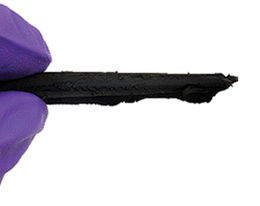Research Abstract
ボロンによって誘導されたナノ接合による共有結合した3次元カーボンナノチューブ固体
Covalently bonded three-dimensional carbon nanotube solids via boron induced nanojunctions
2012年4月13日 Scientific Reports 2 : 363 doi: 10.1038/srep00363

カーボンナノチューブ(CNT)の間に共有接合を作ることと、CNTの直管状の形態を変えることは、ナノチューブから作られる優れた材料特性を示す3次元(3D)骨格の合成を成功させるのに必要な2つの方策である。スケーラブルな合成プロセスでそのような3D構造体を作るのは、まだ難題である。本研究では、化学気相成長時のボロン・ドーピングにより巨視的スケールの3Dナノチューブ弾性固体を直接バルク合成する手法を開発している。このボロン・ドーピングは、原子スケールの「エルボー」接合とナノチューブ相互の共有結合連結に影響を与える。詳細な元素分析によって、「エルボー」接合部は余剰ボロン原子の優先サイトであることが明らかになった。この結果は、接合形成機構におけるボロンと湾曲の役割を示しており、我々の第一原理理論計算と一致する。この材料の超軽量、超疎水性、高い多孔性、熱安定性、機械的柔軟性を利用して、この親油性の強いスポンジに似た固体が、繰り返し使用した後でも汚染された海水から油を効率的に除去できる特異な再利用できる吸着剤骨格であることが実証されている。
- ライス大学 Department of Mechanical Engineering & Materials Science(米国)
- Campus Universitario(スペイン)
- オークリッジ国立研究所 Materials Science&Technology Division(米国)
- レンセラー工科大学(米国)
- ライス大学 Department of Physics(米国)
- イリノイ大学アーバナ・シャンペーン校(米国)
- IMM(CNM-CSIC)(スペイン)
- Air Force Research Laboratory(米国)
- アリゾナ州立大学(米国)
- オークリッジ国立研究所Center for Nanophase Materials Sciences(米国)
- Applied Physics & Astronomy(米国)
- Institute of Condensed Matter and Nanosciences (ベルギー)
- ペンシルベニア州立大学(米国) & エキゾチック・ナノカーボン(ENCs)の創成と応用プロジェクト拠点(JST)(日本)
The establishment of covalent junctions between carbon nanotubes (CNTs) and the modification of their straight tubular morphology are two strategies needed to successfully synthesize nanotube-based three-dimensional (3D) frameworks exhibiting superior material properties. Engineering such 3D structures in scalable synthetic processes still remains a challenge. This work pioneers the bulk synthesis of 3D macroscale nanotube elastic solids directly via a boron-doping strategy during chemical vapour deposition, which influences the formation of atomic-scale “elbow” junctions and nanotube covalent interconnections. Detailed elemental analysis revealed that the “elbow” junctions are preferred sites for excess boron atoms, indicating the role of boron and curvature in the junction formation mechanism, in agreement with our first principle theoretical calculations. Exploiting this material’s ultra-light weight, super-hydrophobicity, high porosity, thermal stability, and mechanical flexibility, the strongly oleophilic sponge-like solids are demonstrated as unique reusable sorbent scaffolds able to efficiently remove oil from contaminated seawater even after repeated use.

